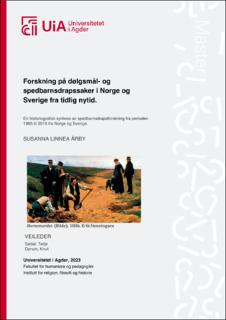Forskning på dølgsmål- og spedbarnsdrapssaker i Norge og Sverige fra tidlig nytid. En historiografisk syntese av spedbarnsdrapsforskning fra perioden 1965 til 2019 fra Norge og Sverige.
Master thesis
Permanent lenke
https://hdl.handle.net/11250/3072738Utgivelsesdato
2023Metadata
Vis full innførselSamlinger
Sammendrag
The theme for this dissertation is Norwegian and Swedish research on infanticide (spedbarnsdrap) in the early modern period. Infanticide is the definition for mothers who had committed murder on their newborn child. This was the crime for which women in Norway and Sweden were most often executed for in early modern times. The main purpose of this thesis is to give a histographic review of the most significant studies on infanticide from Norway and Sweden published between 1965 to 2019. Such an analysis has not previously been carried out for Norwegian and Swedish infanticide research. What er the trends in the research field and peculiarities of the related research? And, if I compare what the research from both countries can tell about legislation, legal practice and characteristic features of the women who committed infanticide, are the answers the same? The main source for this dissertation is a wide amount of secondary literature, with the pioneers of the research field Lisabet Risa and Erik Anners as important contributions to the field. Two theoretical approaches which repeats itself in the field is the state of power perspective (maktstatperspektiv) and the interaction perspective (interaksjonsperspektiv). The use of the perspectives was to explain the way laws and jurisprudence was practiced by the state and the way the public could influence the state.
I was able to locate 19 Norwegian research contributions and 17 Swedish publications that highlight infanticide to a greater or lesser extent. The most central findings that are repeated in both Norwegian and Swedish research were that most of the mothers that committed infanticide were unmarried maids. They got pregnant by men they were not married to or with a man who was already married. In my review there are three recurring motifs found in Norwegian and Swedish research. Shame, poverty and who the child´s father were the most used motifs for the unmarried mothers. I have found that there are several similarities for the studies on infanticide. One of them is how the historians approach the source material trough method uses. The methods I conclude are the most used in the research from both countries are qualitative and quantitative methods, and they often combine these two methods. A trend that shows itself in research development is the transition from dealing with the general to the more specific. For Norway this concerned the transition from major topics such as morality legislation (sedlighetslovgivning) to case studies of individual infanticide cases. For the Swedish research, I found that the development within the field started whit dealing with the big social development issue to case study at a local level. One of the differences between the Norwegian and Swedish research is the size of the geographical area used in the analysis, this applies especially to first-generation researchers. Where the Swedish researchers had the whole of Sweden as a geographical area, while Norway stuck to cities or villages.
